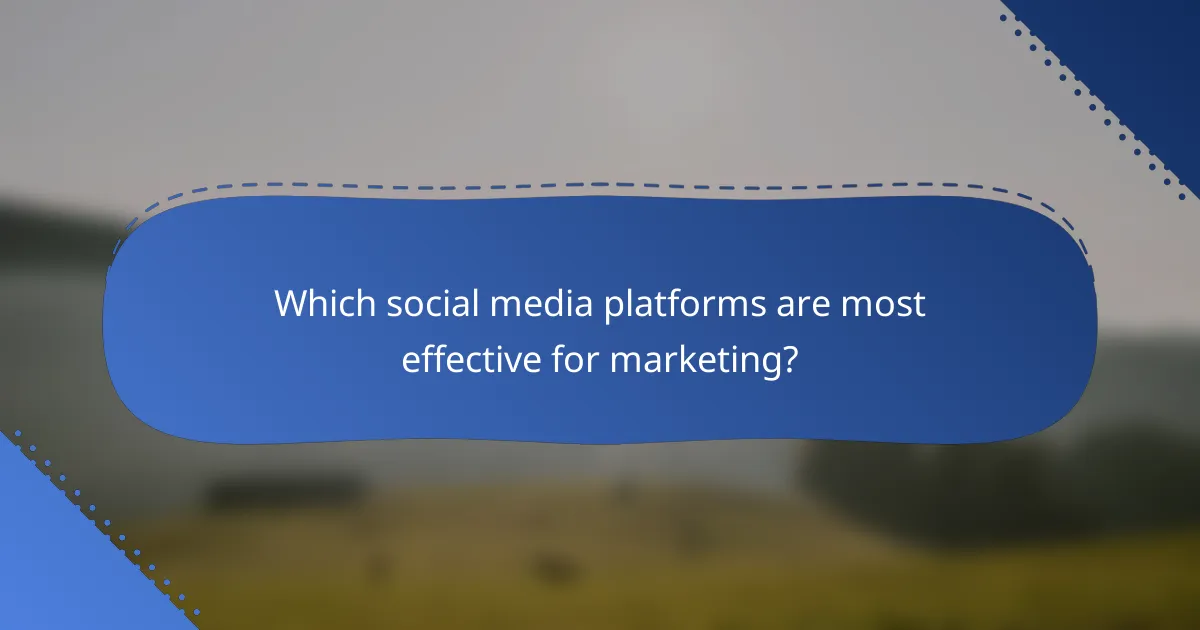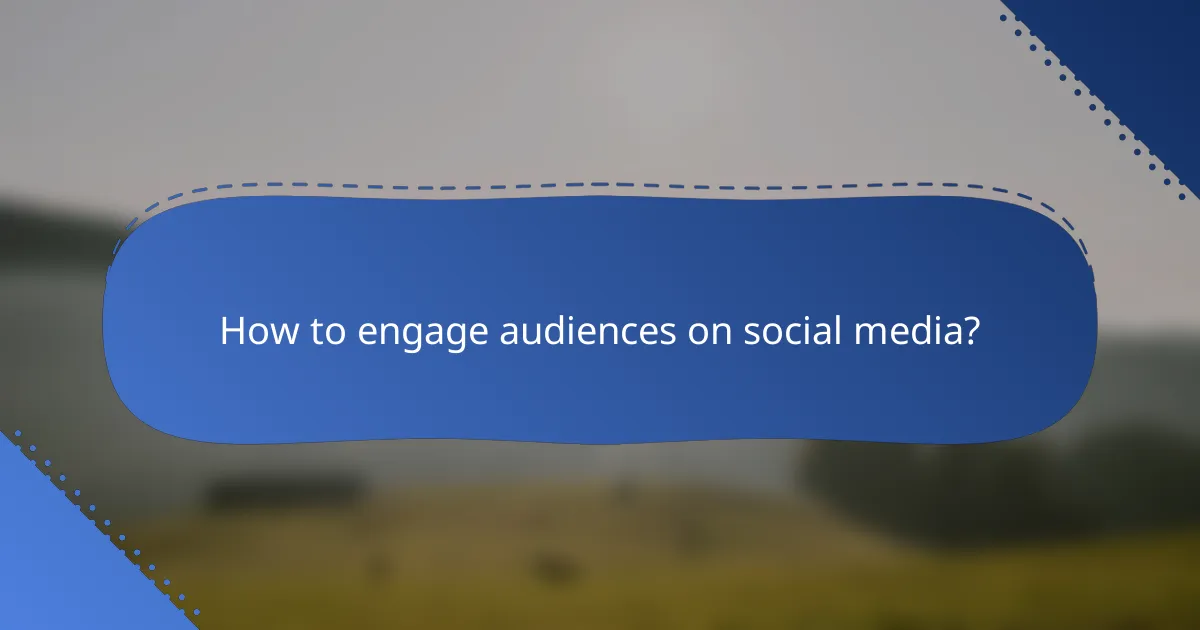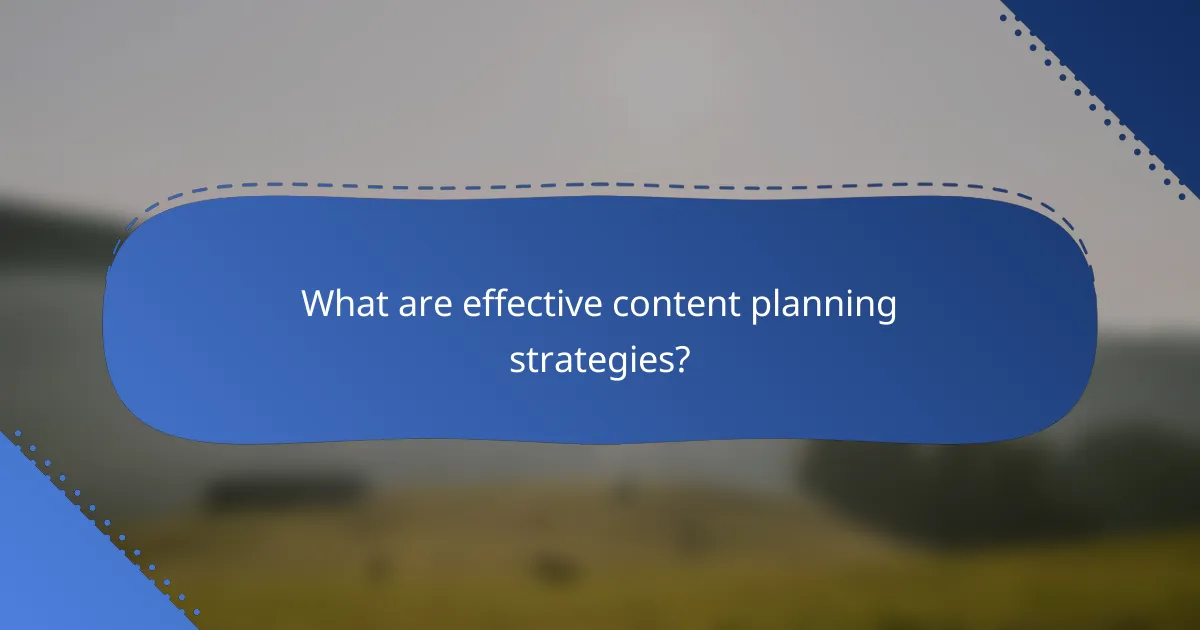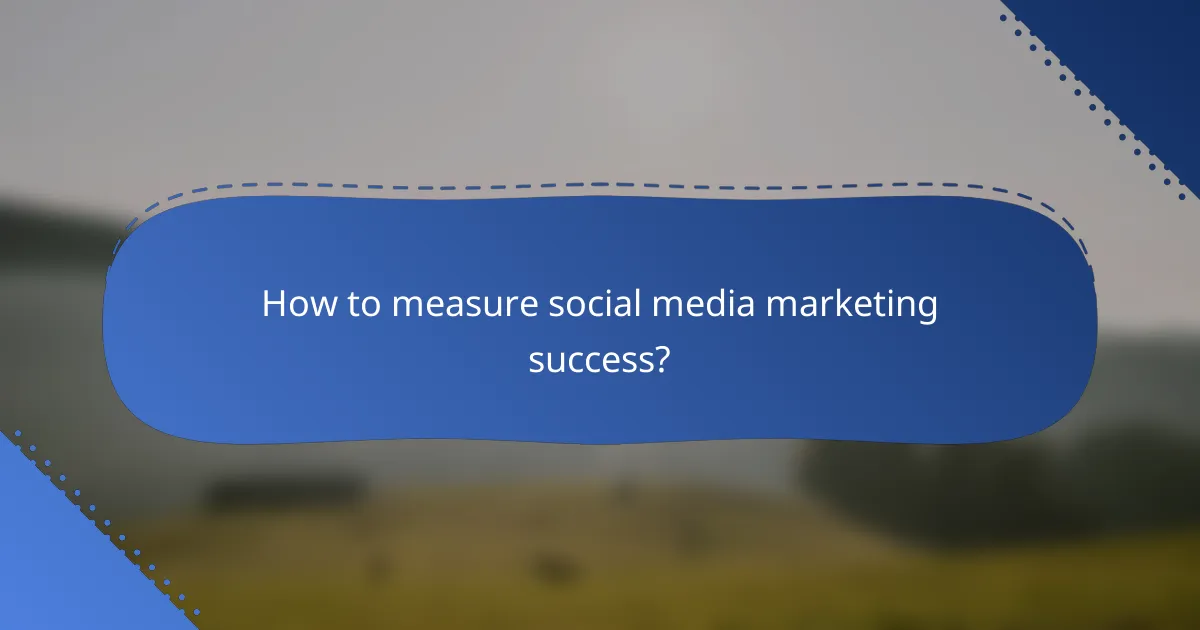Social media marketing is a dynamic field that requires a deep understanding of various platforms and their unique strengths. By leveraging platforms like Facebook, Instagram, LinkedIn, Twitter, and TikTok, marketers can tailor their strategies to engage specific target audiences effectively. Successful engagement hinges on creating meaningful interactions, while effective content planning ensures that your messaging resonates with users and aligns with their interests.

Which social media platforms are most effective for marketing?
The most effective social media platforms for marketing vary based on target audience and campaign goals. Key platforms include Facebook, Instagram, LinkedIn, Twitter, and TikTok, each offering unique advantages for different marketing strategies.
Facebook for broad audience reach
Facebook remains a top choice for marketers aiming for a wide audience. With billions of active users, it allows brands to connect with diverse demographics through targeted ads and engaging content.
To maximize effectiveness, businesses should utilize Facebook’s advertising tools to segment audiences by interests, behaviors, and location. Regularly posting engaging content, such as videos and polls, can also enhance user interaction.
Instagram for visual engagement
Instagram excels in visual storytelling, making it ideal for brands that rely on imagery. Its emphasis on high-quality photos and videos attracts users looking for inspiration and aesthetic appeal.
Utilizing features like Stories, Reels, and shopping tags can significantly boost engagement. Brands should focus on creating visually appealing content that resonates with their target audience and encourages sharing.
LinkedIn for B2B networking
LinkedIn is the premier platform for B2B marketing, connecting professionals and businesses. It is particularly effective for lead generation, networking, and sharing industry insights.
Companies should create a strong company page and share valuable content, such as articles and case studies, to establish authority. Engaging with industry groups and participating in discussions can further enhance visibility and credibility.
Twitter for real-time communication
Twitter is known for its fast-paced environment, making it suitable for real-time communication and updates. Brands can engage with their audience through timely tweets and responses.
To leverage Twitter effectively, businesses should monitor trends and participate in relevant conversations using hashtags. Regularly sharing news, updates, and engaging with followers can help build a loyal community.
TikTok for younger demographics
TikTok is rapidly gaining popularity among younger audiences, making it a valuable platform for brands targeting Gen Z and Millennials. Its short-form video format encourages creativity and viral content.
Brands should focus on creating entertaining and authentic videos that align with current trends. Collaborating with influencers can also amplify reach and engagement among younger users.

How to engage audiences on social media?
Engaging audiences on social media involves creating meaningful interactions that resonate with users. This can be achieved through various strategies that encourage participation, sharing, and connection with your brand.
Utilize interactive content
Interactive content, such as polls, quizzes, and surveys, encourages users to engage actively rather than passively consuming information. This type of content can significantly increase user interaction and time spent on your posts.
Consider using tools like Instagram Stories or Facebook Polls to create quick, engaging interactions. Aim for a mix of fun and informative content to keep your audience interested.
Leverage user-generated content
User-generated content (UGC) involves sharing content created by your audience, such as reviews, testimonials, or photos featuring your products. This approach not only builds community but also enhances trust and authenticity.
Encourage your followers to share their experiences with your brand by creating specific hashtags or running contests. Highlighting UGC can foster a sense of belonging among your audience and motivate others to contribute.
Run targeted ad campaigns
Targeted ad campaigns allow you to reach specific segments of your audience based on demographics, interests, and behaviors. This precision increases the likelihood of engagement and conversion.
Utilize platforms like Facebook Ads or Google Ads to create tailored campaigns. Monitor performance metrics to refine your targeting and messaging, ensuring your ads resonate with the intended audience.
Host live events and Q&A sessions
Live events and Q&A sessions provide an opportunity for real-time interaction, allowing audiences to ask questions and engage directly with your brand. This format can humanize your brand and foster a deeper connection with your audience.
Platforms like Instagram Live or Facebook Live are ideal for hosting these events. Promote your sessions in advance and encourage participation by addressing audience questions and comments during the event.

What are effective content planning strategies?
Effective content planning strategies involve organizing and scheduling your content to maximize engagement and reach. By implementing structured approaches, you can ensure your content aligns with audience interests and seasonal opportunities.
Create a content calendar
A content calendar is a vital tool for planning and organizing your social media posts. It helps you visualize your content schedule, ensuring consistent posting and timely delivery of messages. Aim to plan at least a month in advance, marking key dates and themes relevant to your audience.
When creating your calendar, include details such as post types, platforms, and publishing times. Tools like Google Calendar, Trello, or dedicated content management software can streamline this process.
Incorporate seasonal trends
Incorporating seasonal trends into your content planning can significantly enhance engagement. Monitor holidays, events, and seasonal changes that resonate with your audience, tailoring your content to reflect these themes.
For example, during the holiday season, consider creating gift guides or festive promotions. Use tools like Google Trends to identify popular topics and keywords relevant to the season, ensuring your content remains timely and appealing.
Analyze competitor content
Analyzing competitor content provides valuable insights into successful strategies and audience preferences. Identify key competitors in your niche and review their social media posts, engagement rates, and content types.
Look for patterns in their most successful posts, such as formats (videos, infographics), posting frequency, and audience interactions. This analysis can inform your content planning, helping you to differentiate your approach while leveraging effective tactics.
Utilize analytics for optimization
Utilizing analytics is crucial for optimizing your content strategy. Regularly review performance metrics such as engagement rates, reach, and audience demographics to understand what resonates with your followers.
Use insights from platforms like Facebook Insights or Instagram Analytics to adjust your content planning. For instance, if video posts receive higher engagement, consider increasing their frequency. Set specific goals and KPIs to measure success and refine your strategy accordingly.

What criteria should be used for platform selection?
Selecting the right social media platform involves evaluating several key criteria that align with your marketing goals. Consider factors such as your target audience, the types of content you plan to create, and your available budget to ensure effective engagement and reach.
Target audience demographics
Understanding the demographics of your target audience is crucial for platform selection. Different social media platforms attract various age groups, interests, and geographic locations. For instance, platforms like Instagram and TikTok are popular among younger users, while Facebook tends to have a broader age range.
To effectively reach your audience, analyze where they spend their time online. Tools like audience insights on each platform can help identify the demographics of your followers and inform your strategy.
Content type suitability
The type of content you intend to produce plays a significant role in platform choice. Visual content, such as images and videos, performs well on platforms like Instagram and YouTube, whereas text-based content may thrive on Twitter or LinkedIn. Assessing the strengths of each platform can guide your content strategy.
Consider creating a content calendar that aligns with the platform’s preferred formats. For example, short videos are ideal for TikTok, while longer articles may be better suited for LinkedIn. Tailoring your content to fit the platform enhances engagement.
Budget considerations
Your budget will influence which platforms you can effectively utilize for marketing. Some platforms offer free access, while others may require paid advertising to reach a wider audience. For instance, Facebook and Instagram provide robust advertising options, but costs can vary significantly based on targeting and competition.
Establish a clear budget for both organic and paid strategies. Allocate funds based on expected return on investment (ROI) and consider starting with a small budget to test different platforms before committing larger amounts. This approach allows for adjustments based on performance metrics.

How to measure social media marketing success?
Measuring social media marketing success involves evaluating various metrics that indicate how well your content is performing and how effectively it engages your audience. Key performance indicators (KPIs) such as engagement rates, reach, and conversion rates provide insights into your overall effectiveness on these platforms.
Track engagement metrics
Engagement metrics are crucial for assessing how well your audience interacts with your content. Common metrics include likes, shares, comments, and click-through rates. Monitoring these figures helps you understand what resonates with your audience and what doesn’t.
To effectively track engagement, use analytics tools provided by social media platforms or third-party applications. Set benchmarks based on past performance, and aim for gradual improvement over time. For example, a good engagement rate typically ranges from 1% to 5%, depending on the platform and industry.
Be mindful of common pitfalls, such as focusing solely on follower count rather than meaningful interactions. Prioritize quality engagement over quantity to build a loyal community. Regularly review and adjust your strategies based on the insights gained from these metrics.
